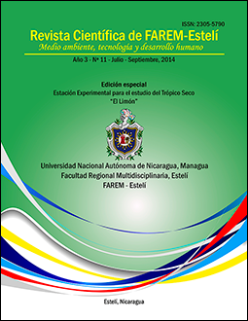Aboveground biomass and allometric models for Acacia pennatula in natural dry tropical conditions Nicaraguan
DOI:
https://doi.org/10.5377/farem.v0i11.1604Keywords:
Biomass, fodder, firewood and allometric equationsAbstract
The research was conducted in the receptacles of secondary growth forest located at the Experimental Station - El Limon, Estelí, Nicaragua; in order to evaluate the production of forage biomass and firewood Coal (Acacia pennatula Schltdl and Cham) Benth, under natural conditions of secondary vegetation in the Nicaraguan dry tropics. To this end, the experiment focused on two phases: 1) determine the production of forage biomass and firewood, 2) generate allometric equations to estimate biomass production of fodder and firewood.
Twenty six individuals of coal included in a wide range of height and diameter at breast height were selected. Later, homogenization pruning was performed at a height of 1.8 meters above the ground, in order that each individual could show its capacity to produce biomass for a period of 6 months. After this period of accumulation, biomass was harvested which was divided into two fractions: forage and woody. For each individual diameter was measured at breast height, the number of regrows, base diameter, the length of each regrowth and fresh weight of fodder and firewood.
Fresh samples of each fraction were taken per individual, which were dried at 60 ° C for 48 hours until reaching a constant weight. Subsequently, the production of both fractions of the total dry biomass per tree was estimated, through the linear prediction model “and” = 0.4357x - 8.3423, highly significant (p = 0.0001 and R = 0.988).
According to the Pearson correlation coefficient, the variables associated with forage production were: base diameter and length of the regrowth (R2 = 0.635), number of regrows (R2 = 0.647) and diameter at breast height (R2 = 0.722). While wood is associated with the base diameter and length of the regrowth (R2 = 0.617 and 0.779), respectively. All of the above correlations were statistically significant (p <0.05). The evaluated variables were fitted to linear regression models.
DOI: http://dx.doi.org/10.5377/farem.v0i11.1604
Revista Científica de FAREM-Estelí No.11 2014: 47-56
Downloads
1129
Downloads
Published
How to Cite
Issue
Section
License
© Revista Científica de FAREM-Estelí

